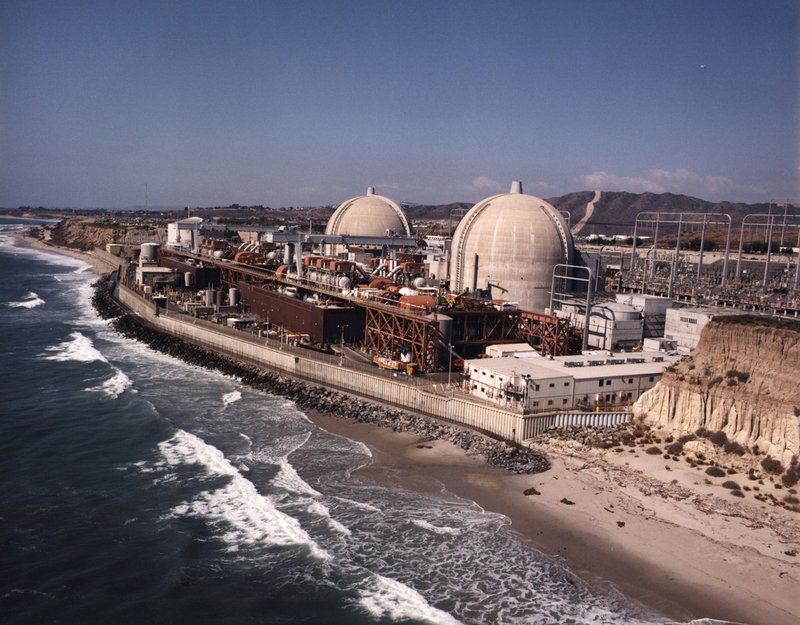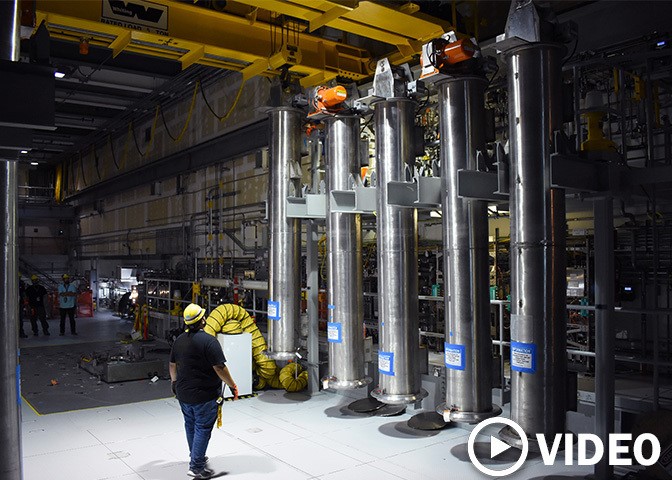Demolition has begun on the Bulk Shielding Reactor at the Oak Ridge National Laboratory. It marks the first teardown of a former reactor at the site. (Photo: DOE).
In a first for the Department of Energy’s Oak Ridge Site, a former reactor facility is being demolished. The site’s cleanup contractor, UCOR, began tearing down the Bulk Shielding Reactor, also known as Building 3010, last week.
“While this project is not the biggest demolition we’ve undertaken, it carries a lot of significance,” said Laura Wilkerson, acting manager for the Oak Ridge Office of the DOE’s Office of Environmental Management (EM). “It is the first removal of a former reactor at [Oak Ridge National Laboratory], and it is a signal of much more to come at the site in the immediate future.”
An illustration of Switzerland’s proposed deep geological repository. (Image: Nagra)
Nagra, Switzerland’s national cooperative for the disposal of radioactive waste, has announced that it has selected Nördlich Lägern as the site for a deep geological repository for radioactive waste. According to Nagra, extensive investigations have shown that Nördlich Lägern, located in northern Switzerland near the German border, is the most suitable area for a geologic repository with the best overall safety reserves.
The Palisades nuclear power plant.
The Nuclear Regulatory Commission has made Holtec International’s post-shutdown decommissioning activities report (PSDAR) for the closed Palisades nuclear power plant available for public comment until December 27. The NRC also plans to hold a public meeting to discuss the report on the evening of September 22 at the South Haven campus of Lake Michigan College, about 10 miles north of the Palisades site in Covert, Mich.
Retention basins at the Liquid Effluent Retention Facility on the Hanford Site, as seen in September 2021, at top, and recently with the nearly completed Basin 41 on the far left. (Photo: DOE)
Work is nearing completion on a fourth basin needed to ensure adequate storage for wastewater during tank waste treatment on the Department of Energy’s Hanford Site, in Washington state.
According to the DOE, its operations contractor Washington River Protection Solutions (WRPS) has made significant progress on Basin 41 at the Liquid Effluent Retention Facility (LERF) since concrete was first poured for the perimeter one year ago.
Video: Watch this time-lapse video of the LERF Basin 41 construction.
DOE contractor Savannah River Mission Completion strengthened its ties with Aiken Technical College as the school graduated the first class of Nuclear Fundamentals trainees this summer. (Photo: DOE)
The first 36 students graduated this summer from Savannah River Mission Completion’s (SRMC) Nuclear Fundamentals Certificate program. SRMC is the Department of Energy’s liquid waste contractor at the Savannah River Site (SRS) in South Carolina.
The program, which is a partnership between Aiken Technical College (ATC) and SRMC, is in its inaugural year.
The San Onofre nuclear power plant.
The San Onofre Nuclear Generating Station (SONGS) recently shared a few videos on its YouTube channel, showing recent progress Southern California Edison has made in dismantling the plant’s turbine building. Decommissioning of the nuclear power plant, which permanently ceased operations in 2013, is being conducted by SONGS Decommissioning Solutions, a joint venture of EnergySolutions and AECOM.
While many Californians are hopeful the state’s last nuclear power reactor can be saved, PG&E is actively preparing for decommissioning.
The Diablo Canyon nuclear power plant in San Luis Obispo County, Calif.
(Photo: Wikimedia Commons)
The reports of the death of the Diablo Canyon nuclear power plant may be greatly exaggerated. While Pacific Gas and Electric (PG&E) announced as early as 2016 that it would be closing California’s last operating nuclear power plant at the end of its current operating license, there has been growing political pressure to keep the plant, and its 2,200 MWe of carbon-free energy, running.
A worker watches test bubblers in operation at the Hanford Site. (Photo: DOE)
The B Farm underground waste tank area at Hanford. (Photo: DOE)
Washington state’s Department of Ecology and the U.S. Department of Energy have agreed on a plan for how to respond to two underground tanks that are leaking radioactive waste, as well as any future tank leaks, at the Hanford Site near Richland, Wash.
In April 2021, following a year-long leak assessment, the DOE announced that Hanford’s Tank B-109 is leaking waste into the surrounding soil. Tank T-111 was discovered to be leaking in 2013. Currently, Tank B-109 is leaking about 1.5 gallons of waste per day, and Tank T-111 is leaking less than a gallon a day, according to the DOE.
WIPP Blue Team participates in a final briefing before beginning a field contest in a recent national mine rescue competition. (Photo: DOE)
Mine rescue teams from the Department of Energy’s Waste Isolation Pilot Plant (WIPP) finished in the top 15 in competitions at the first-ever joint Coal, Metal, and Nonmetal National Mine Rescue Contest in Lexington, Ky., held on August 7–12.
Crews begin clearing the site on which Savannah River Site’s SDU 10 will sit. (Photo: DOE)
The Department of Energy’s Office of Environmental Management (EM) announced that it is preparing for construction of the final three planned saltstone disposal units (SDUs) at the Savannah River Site in South Carolina, which will complete the site’s liquid waste mission.
The SRS liquid waste contractor, Savannah River Mission Completion (SRMC), is overseeing the construction of the SDUs, which will receive decontaminated salt solution treated at Savannah River’s Salt Waste Processing Facility (SWPF).
Ontario’s South Bruce area is being considered as a potential host site for a spent fuel repository. (Photo: NWMO)
Canada’s Nuclear Waste Management Organization (NWMO) is shifting the timing for selecting a preferred site for a spent nuclear fuel repository to the fall of 2024, a full year later than previously planned. The NWMO, a nonprofit organization tasked with the safe, long-term management of Canada’s spent fuel in a deep geological repository, said the delay is the result of several provincial lockdowns associated with the COVID-19 pandemic.
Hanford workers will soon begin retrieving about 373,000 gallons of waste from Tank AX-101, shown here in an image from an inspection video shot. (Photo: DOE)
Washington River Protection Solutions (WRPS) is preparing to retrieve waste from Tank AX-101 at the Department of Energy’s Hanford Site near Richland, Wash. WRPS is the tank operations contractor at Hanford.
Schematic of a deep horizontal borehole repository for nuclear waste. (Image: Deep Isolation)
Deep Isolation announced that it has signed a memorandum of agreement with engineering services company Amentum to further the commercialization of Deep Isolation’s nuclear waste storage and disposal technology around the world. The initial targets for joint work include locations in Europe and the Pacific that represent a combined market for geologic disposal of spent fuel and high-level waste worth more than $30 billion, the company said.
Members of the UCOR team receive their award at a Top Workplaces event.
United Cleanup Oak Ridge (UCOR), the lead environmental cleanup contractor for the Department of Energy’s Oak Ridge Office of Environmental Management (OREM), has been named one of the Knoxville News Sentinel’s “Top Workplaces” in eastern Tennessee for 2022. The award is the result of a confidential, third-party survey of UCOR’s 2,000-member workforce by the Knoxville News Sentinel and the survey company Energage.
A contamination suit provided by the EM Nevada Program is on display in the new exhibit at the National Atomic Testing Museum. (Photo: DOE)
The Department of Energy’s Office of Environmental Management (EM) celebrated the opening of a new exhibit at the National Atomic Testing Museum in Las Vegas during a ceremony on August 2.
Created through a partnership between EM and the museum, the permanent exhibit, “Beyond the Manhattan Project: Cleaning up the Legacy of America’s Nuclear Defense and Research Missions,” offers a visual display of EM’s critical work to clean up sites across the country impacted by five decades of nuclear weapons production and government-sponsored nuclear energy research.




















